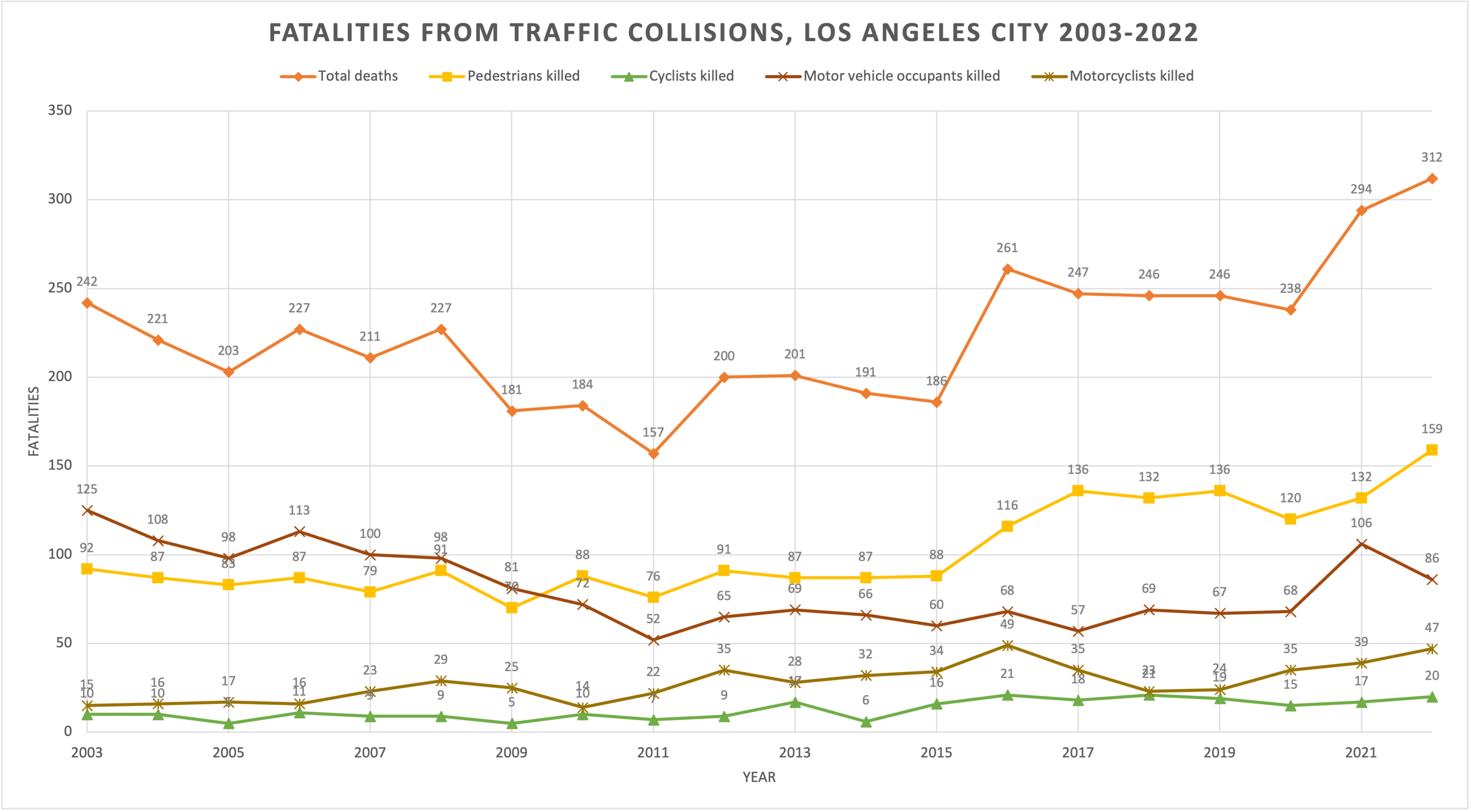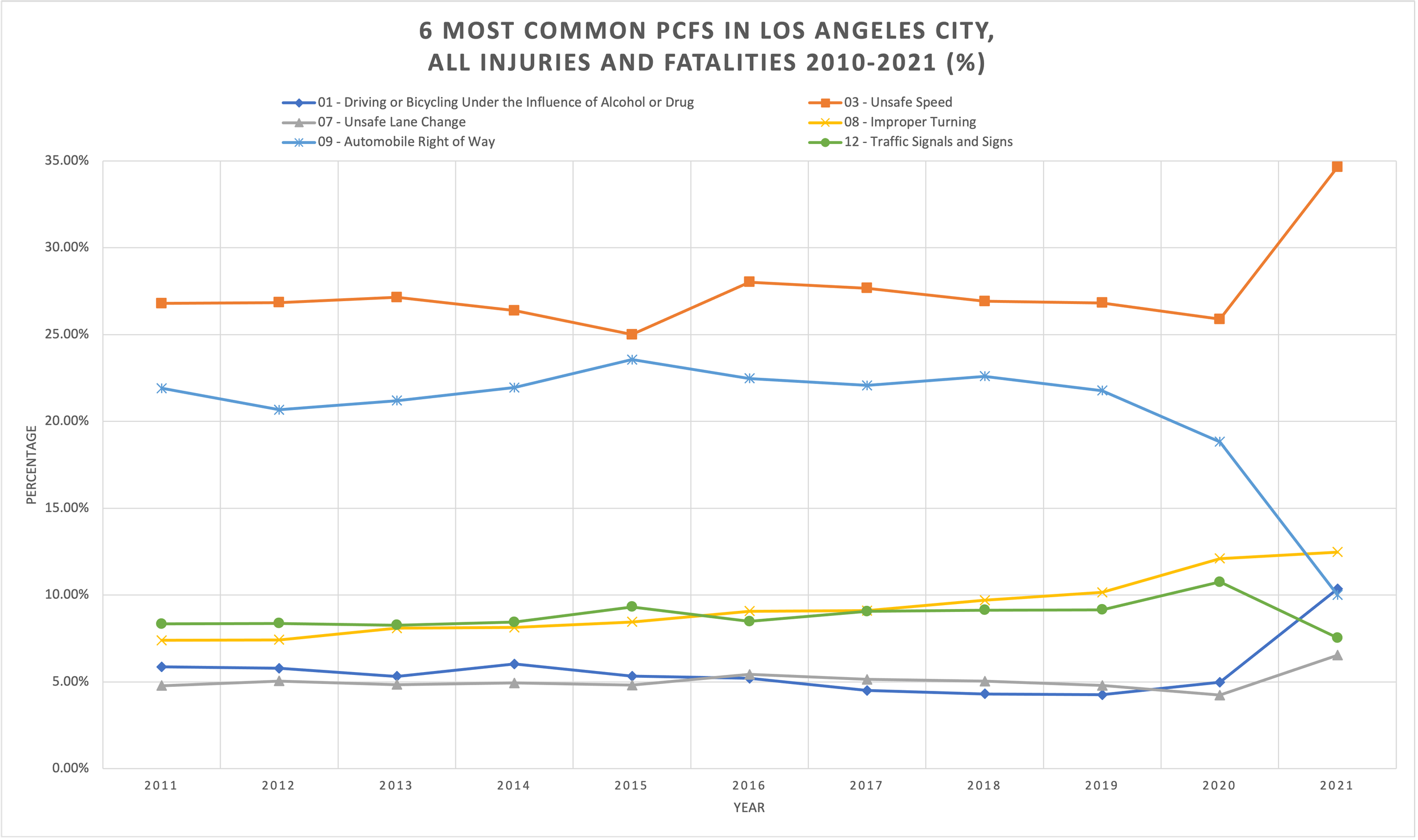Dying on the Streets of Los Angeles: 2022 Traffic Fatalities, Why & What Needs to Change
Written by Damian Kevitt, Executive Director of Streets Are For Everyone, with assistance from Sue Favor and Arman Koohian.
10 January 23, revised 18 January 23
For the last several years, the holidays in Los Angeles have served as a grim reminder that the streets of this otherwise world-class city are fast and deadly. As Streets Are For Everyone (known as SAFE) rang in the new year, we learned that 2022 was no exception.
There were 312 traffic fatalities in 2022, breaking the 300 mark for the first time in over 20 years, which is how far our records reach. This was an increase of 6% from the previous year and a staggering 29% increase over 2020.
Source: City of Los Angeles Open Data Portal. Taken from LAPD records. Figures are preliminary and subject to change as data is reviewed and finalized.
This is a tragedy made worse by the fact that vulnerable road users – pedestrians (primarily youth 29 and younger as well as seniors 50 and older) and cyclists – are impacted the most by traffic violence in Los Angeles. Pedestrian fatalities were up by 20% (159 lives lost, also the highest in 20 years) compared to 2021 and 30% compared to 2020. Bicycle fatalities also increased by 18% (21 lives lost) and were higher than in 2020 by 33%.
While motor vehicle fatalities are still at higher levels compared to 2020, they dropped by 8% in 2022.
Source: City of Los Angeles Open Data Portal. Taken from LAPD records. Figures are preliminary and subject to change as data is reviewed and finalized.
LA’s UNHOUSED ARE KILLED FAR MORE BY TRAFFIC VIOLENCE
With the Mayor’s attention focused on addressing those unhoused in Los Angeles we wanted to look at traffic fatalities for the unhoused in Los Angeles. SAFE obtained from the LAPD the number of unhoused individuals killed in traffic collisions on the streets of Los Angeles from 2018 to 2022.
Per the latest homeless count, the current population of unhoused individuals in 2022 stands at 41,980, but the current population of the City of Los Angeles is over 4 million. To make a fair comparison, we have to compare the per capita (per 100,000 individual) fatalities of housed pedestrians and cyclists to unhoused pedestrian and bicycle fatalities.
What was found? On average (2018-2022), housed pedestrians and cyclists in Los Angeles are killed at a rate of 2.9 per capita (100,000 individuals), a rate that is significantly higher than the national average of 2.2 per capita. However, on average (2018-2022), 116.6 unhoused individuals per capita are killed by traffic violence every year. That is 40.2X more than housed pedestrians and cyclists in Los Angeles and 53X the national average.
WHAT IS BEHIND THE NUMBERS? SPEED!
We wanted to see what was behind these fatalities — what were the primary collision factors (PCF), as they are called by law enforcement. While we do not have a breakdown of the PCF data for 2022, we looked at the primary collision factors for the spike in fatalities in 2021 compared to earlier years. (We assume that since things have worsened, there would be no significant change between 2021 and 2022.)
What did we find? The resounding answer is speed. Speeding is the primary collision factor in 34.8% of the collisions in LA, resulting in some degree of injury or fatalities.
Source: TIMS
This has been true every year since 2010; however, it has become significantly worse since 2020.
Source: TIMS
With so many people sucked into their cell phones while driving, new infotainment systems in more and more cars, and many other sources of internal and external distractions, it is likely that distracted driving is also a “major collision factor.” In April 2006, a study released by the Virginia Tech Transportation Institute and the NHTSA found that almost 80% of crashes and 65% of near-crashes involved some form of driver inattention within three seconds of the event.
Distracted driving is not noted as a collision factor (primary or otherwise) by LAPD, so it is hard to say how much distracted driving plays into the increase in fatalities. What we do know for sure is that Angelenos as a whole are speeding more and paying less attention to the most vulnerable road users: pedestrians and cyclists.
VISION ZERO ON LIFE SUPPORT
The Vision Zero strategy was initiated in 2015 by the then mayor, Eric Garcetti, to protect the most vulnerable road users and reduce traffic fatalities to zero by 2025. It launched with an impressive roll-out of grand plans, but, by statistics, it has largely been a failure, suffering from a lack of political will, lack of funding, and now, severe staff shortages.
Vision Zero started with a multi-faceted approach, including “the 5 E’s”: equity, evaluation, education, engineering, and enforcement. Around 2019, enforcement and education as tools were de-emphasized in favor of primarily re-engineering the roads to make them safer. While this sounds like a great plan on paper, re-engineering roads is time-intensive and very expensive, requiring a lot more investment upfront to start seeing an improvement in serious injuries and fatalities.
In the 2022-2023 LA City fiscal budget, $50.6 million was allocated to LA DOT for Vision Zero related projects. This is a drop in the bucket compared to what cities that are serious about saving lives spend. For example, the City of New York, with fewer miles of streets – 6300 miles in New York City compared to 6614 miles in LA City – spent over $270 million on its Vision Zero program in the 2019 fiscal year alone. It also had fewer traffic fatalities than Los Angeles in 2021 (273 in NY compared to 294 in LA) with twice the number of people living there.
To make things worse in LA, due to a severe staffing shortage at LA DOT — per a May 2022 LAist Article, 50% of the Vision Zero and Active Transportation positions remain unfilled — approximately 15 million dollars for traffic signal upgrades was left unspent in 2021. That money rolled over to the 2022 budget. Many of those positions are still yet to be filled due to an understaffed and overloaded City of LA Personnel Department.
On 30 March 2022, Councilmember Paul Koretz got a motion approved requiring the City Controller to audit LA’s Vision Zero program to “prevent future fatalities and serious injuries.” While this was a good idea, it is now over 9 months later, and the audit has yet to be completed, which just goes to show how low a priority saving lives is on the streets of Los Angeles.
HERE’S HOW MAYOR BASS AND THE LA CITY COUNCIL CAN TURN AROUND THIS DEADLY TREND
If Mayor Bass and our City Councilmembers, many of them newly elected, are serious about actually saving lives on the streets of Los Angeles, they are going to have to make some drastic changes related to Vision Zero, not just for one year but for many years. SAFE’s 4 recommendations are
Cut the Bureaucracy
Treat the spike in lives lost due to traffic collisions on the streets of Los Angeles as the public health crisis that it is. This means issuing a State of Emergency Declaration for Traffic Fatalities and Serious Injuries, forcing city departments to prioritize working together to address the spike in fatalities. This means fast-tracking hiring the personnel needed by LA DOT for road safety projects. It also means completing the audit of Vision Zero in the next few weeks, not months.
2. Reestablish Vision Zero with Accountability, Transparency, and PURPOSE
Vision Zero was launched in 2015 with a multi-agency Executive Steering Committee that included representatives from the LA Mayor’s Office, LA DOT, LAPD, Bureau of Engineering, Streets LA, LAFD, Dept of City Planning, and the LA County Dept of Public Health. Per an LA DOT official we recently talked to, this larger Executive Steering Committee stopped regularly meeting in 2018 and has, at least from our perspective, been dissolved. Smaller subgroups, for example, meetings between LA DOT and LAPD, have continued.
The LA Mayor’s Office needs to re-establish the Executive Steering Committee with accountability, transparency, and PURPOSE, not as just another bureaucratic meeting to waste people’s time and taxpayer money. This means that
Community groups that work on road safety issues, like SAFE, need to have a voice at the table, be allowed to bring constructive criticism to the process, and be allowed to bring community input to the very highest levels of the program.
It means that the purpose of the Vision Zero Executive Steering Committee, to reduce traffic fatalities and serious injuries, needs to be first and foremost with regular reporting to and direction given by the LA Mayor.
It means that each City Councilmember needs to take an interest in Vision Zero as it relates to their area and the city as a whole and update their constituents on progress made, just as they do on the issue of homelessness.
Lastly, it means that the Executive Steering Committee needs to be accountable to the people of Los Angeles with regular public quarterly reports on traffic fatalities and serious injuries by council district, as well as the actions being taken on a short-term and long-term basis to prevent further trauma.
3. Prioritize Lives over the Right to Speed
This means getting state legislation passed to allow the limited use of automated speed enforcement (ASE) on the most dangerous roads, at school zones that are known to be deadly, and along known street racing corridors. This needs to be done equitably, with significantly reduced fines (or even just warnings) for Angelenos who already live near or below the poverty line.
With ASE technology implemented, reduce the use of police for traffic enforcement that is known to be racially biased and that issue expensive tickets which disproportionately penalize those struggling to keep food on the table and pay the rent.
Until ASE can be implemented, on a short-term basis, focus traffic enforcement on the most dangerous corridors where serious injuries and fatalities regularly occur, by statistic.
4. Get Real About the Magnitude of the Problem
Throwing only $50.6 million at road safety issues in a city this big, especially considering how many lives are being lost, is a joke. That said, it makes sense if LA DOT is so starved of personnel that it left $15 million in funding for road safety improvements on the table last year.
Mayor Bass and LA City Council need to
Provide LA DOT with the personnel needed to honestly implement Vision Zero and related programs at the magnitude needed to start making a difference. See point A above.
Only after LA DOT has sufficient personnel, LA City Council needs to 4X the funding for Vision Zero and related programs in 2023-2024 and commit to increased funding for at least the next 10 years.
LA City Councilmembers must adhere to their own Mobility 2035 plan. Mobility 2035 was another grand plan to improve mobility in LA and make it safer for all road users. It was passed unanimously by LA City Council in 2015, but between individual councilmembers deciding not to follow it, and a lack of funding, it has only had 3% of the road safety improvements implemented as of early 2022.
These 4 action items are broad strokes and need to translate down to thousands of individual improvements and changes at the street level to stem the flow of blood on our streets due to traffic violence. But as broad strokes, all of these recommendations are vital. We — at SAFE, the citizens of Los Angeles, and the media — will know how much our elected officials actually care about the importance of saving lives in Los Angeles by how much these recommendations are embraced.




